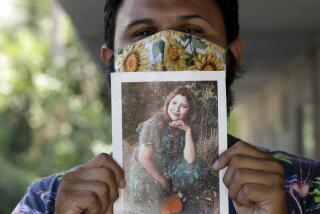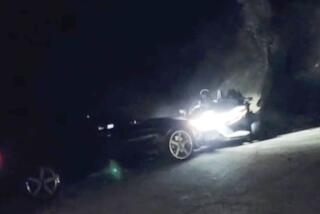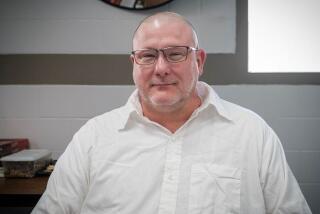Plea Bargain May End Insurance Fraud Case
A widely watched and unprecedented insurance fraud case may end Tuesday if a plea bargain is reached between prosecutors and a defense attorney representing Gary P. Miller, the Encino lawyer charged with second-degree murder for his role in a staged freeway collision.
Both sides confirmed that negotiations for a plea agreement were underway in the case that helped draw nationwide attention to the practice of staged accidents and the complicity of doctors and lawyers who profit from such schemes.
“One of two things will happen on Tuesday,” said Deputy Dist. Atty. Leonard J. Shaffer, who is assigned to the case. “Either we will reach an agreed disposition or we will begin picking a jury.”
Miller, 53, is believed to be the first attorney charged with murder stemming from an insurance fraud case of this type.
Although Miller was not present at the time of the accident, prosecutors allege that he is responsible for the 1992 death of 29-year-old Jose Luis Lopez Perez. Perez, a Salvadoran immigrant, was crushed when the car he was riding in intentionally swerved in front of a big rig, forcing a wreck on the Golden State Freeway in Sun Valley.
According to prosecutors, Miller, a personal injury lawyer, set in motion the events that led to Perez’s death. The act of staging a big rig accident is inherently dangerous and automatically implies malice, a mental condition a jury must find to convict for second-degree murder.
Defense lawyer Harland Braun said the case was “over-filed from the beginning.”
“The death was an accident,” Braun said. “A felon killed himself and the D.A.’s office early on touted this as a huge case. Most people would be concerned if an innocent person was killed. The fact that a guy who was actually setting up the wreck was killed, that’s the risk you take. It’s sort of like an arsonist burning himself up.”
Shaffer, though he declined to discuss why he is now discussing the possibility of a plea bargain, said the talks do not mean that there is a flaw in the prosecution’s legal theory. He also noted that three judges have said there is enough evidence to proceed.
If accepted, the charge of second-degree murder would be dropped in exchange for Miller’s admission of guilt to a lesser charge.
Michael D. Chaney, a criminal defense attorney specializing in white-collar crime matters, said the case, regardless of whether it’s settled, is significant because it demonstrates the willingness of prosecutors to apply criminal liability beyond its traditional limits.
But Chaney was also skeptical of the murder charge.
“The prosecution is really saying that [the death] was a foreseeable and intended result of the conduct with which Miller is charged, staging accidents, and I think that’s really stretching things,” Chaney said.
The possibility that the case may not go to trial has baffled and disappointed some who have watched or participated in the case, including Barry Thorpe, a former deputy district attorney who prosecuted the case until his departure from the D.A.’s office last year.
“It would be a complete puzzle,” said Thorpe, who has joined a private firm representing insurance companies. “I know the significance of that case in the insurance community. I know the significance of that case in my office during the time I was prosecuting the matter.”
Most of all, Thorpe said, was the case’s potential deterrent effect.
“Litigating that one case in front of a jury would have a greater impact in deterring insurance fraud than any other cases they can pursue,” Thorpe said.
Sgt. Marco Ruiz, who investigated the accident for the California Highway Patrol, said the case was “a classic case of a staged collision that was successfully investigated.”
“They don’t always work this way; you don’t always get to the bad guy,” he said. “If it goes to trial, I think the message will be clear. If they plea bargain this one down, I think it kind of dilutes the message.”
The accident occurred June 17, 1992, as Perez and three others cruised the freeway in the northeast Valley. According to grand jury testimony, Jorge Sanchez, the driver of the car, swerved in front of a big rig several times, eventually forcing it to jackknife. The car was crushed beneath the truck, killing Perez.
After the accident, CHP investigators tracked down the owner of the car, Oscar Portillo, who readily admitted his involvement in staged accidents, Ruiz said. Portillo led authorities to Filemon Santiago, the “capper,” or the person who sets up a wreck.
Eventually, investigators uncovered a ring of about 30 people who had been responsible for several big-rig freeway accidents.
“It was probably the most labor-intensive case that I have ever been associated with,” Ruiz said.
Typically, those who are willing to participate in a staged wreck are poor people. They are paid about $1,000 to sit in a car that will be hit by a big rig, Ruiz said.
Many of those who were interviewed “pointed the finger to the same capper, Santiago, and the same attorney, Gary Miller,” Ruiz said.
Miller was arrested and held on $1-million bail. He has since been released but has not practiced law since 1993 when the state bar placed him on “inactive” status.
In 1994, Sanchez, the driver of the car, pleaded guilty to vehicular manslaughter and conspiracy to commit insurance fraud in exchange for having a murder charge dropped. Sanchez was sentenced to four years in prison.
Santiago, Rubidio Lopez, Isiais Antonio Aguilar Martinez are also charged with second-degree murder and insurance fraud. Shaffer said he is also discussing a plea bargain with their attorneys.
If the case goes to trial, a jury would have many options, including finding Miller and the others guilty of the lesser charge of vehicular manslaughter, Shaffer said.
A settlement would not diminish the significance of the case, Shaffer said.
“I think the significant thing is that he was charged with a homicide, whether it’s second-degree murder or something else,” he said. “It’s being charged with the responsibility for someone else’s death.”
Times staff writer Hugo Martin contributed to this story.
More to Read
Sign up for Essential California
The most important California stories and recommendations in your inbox every morning.
You may occasionally receive promotional content from the Los Angeles Times.










